Adrian Collins's Blog, page 60
April 8, 2024
REVIEW: Diavola by Jennifer Thorne
Jennifer Thorne brings supernatural terror to an already dysfunctional family vacation in Diavola, which follows the Pace family on their ill-fated Italian holiday. Although the family’s surname translates to “peace” in Italian, they are not given a moment’s rest as their rental home turns out to be an infamous haunted house, feared and shunned by the local populace.
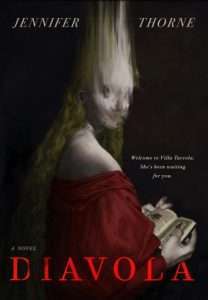 The lead protagonist in Diavola is Anna Pace, the black sheep of the family who is treated like an outcast and can never live up to their expectations. Rightfully or not, Anna takes the blame for many of the family’s misfortunes. Thorne reaches a T. Kingfisher-level of narration with Anna: she is smart, funny, and so vibrantly engaging that it’s impossible not to love her.
The lead protagonist in Diavola is Anna Pace, the black sheep of the family who is treated like an outcast and can never live up to their expectations. Rightfully or not, Anna takes the blame for many of the family’s misfortunes. Thorne reaches a T. Kingfisher-level of narration with Anna: she is smart, funny, and so vibrantly engaging that it’s impossible not to love her.
As in her previous novel, Lute, Jennifer Thorne both embraces and upends the trope of naïve, unbelieving Americans who face a supernatural threat in an historic European setting. Diavola exploits this clash of cultures to great effect, skillfully walking the line between camp and deathly serious horror. At its best, the laugh-out-loud moments in Diavola are worthy of Oscar Wilde’s classic short story, “The Canterville Ghost,” which also features an American family who take up residence in an old European haunted house while expressing a stubborn disbelief in local legends.
Although this approach risks becoming self-parody in less capable hands, Jennifer Thorne’s incisive, sardonic writing strikes just the right balance between humor and horror. She is also an expert at characterization: a large part of what makes Diavola work so well is that the Pace family is so believable in their dysfunction.
I especially enjoyed the final third of the novel, where Thorne brilliantly ties together the various threads of the story while delivering plenty of unexpected twists. I was delighted by Anna’s character growth in this final part of Diavola as she addresses issues of loneliness and belonging while fighting back against the embodiment of fear itself.
Altogether, Diavola is a must-read for horror fans, delivering a thrill ride that is equal parts fun and terrifying.
Read Diavola by Jennifer ThorneThe post REVIEW: Diavola by Jennifer Thorne appeared first on Grimdark Magazine.
April 7, 2024
REVIEW: Lost Ark Dreaming by Suyi Davies Okungbowa
In Lost Ark Dreaming by Suyi Davies Okungbowa the seas have risen on the coast of Nigeria. Inside the Fingers—five towers submerged up to level 34 built to house the people who could afford a room and escape the global catastrophe—what feels like one of the last bastions of humanity dwell amongst crumbling technology trapped into class-based levels. In a novella that feels a lot like the author took Snowpiercer, stood it up to point at the sky, submerged the back end of it, and played it out with a new cast in a different part of the world and culture, Lost Ark Dreaming delves deep into a lot of modern themes around the way we treat and mistrust and discriminate against each other in a beautiful, poetic, dreamlike written way.
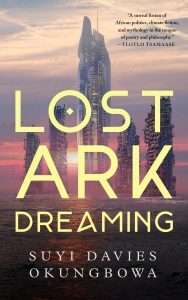 In this post-environmental-apocalypse novella, Lost Ark Dreaming is told through the eyes of Yekini, a technician in the corporation / government department responsible for parsing communications to send to those in command on the upper levels of her tower. Late to work, again, she is tasked (as opportunity or punishment) with going down to the submerged levels to help investigate some damage to an airlock. Ngozi, a higher level member the corporation, gets put on the same job, something he sees as below him as he strives to climb the corporate ladder. Tuoyo is the foreman of the level and airlock in question, and sent the message upstairs to notify them of a breach in the airlock—something feared by the tower as the terrifying Children try to gain access from the dark waters outside.
In this post-environmental-apocalypse novella, Lost Ark Dreaming is told through the eyes of Yekini, a technician in the corporation / government department responsible for parsing communications to send to those in command on the upper levels of her tower. Late to work, again, she is tasked (as opportunity or punishment) with going down to the submerged levels to help investigate some damage to an airlock. Ngozi, a higher level member the corporation, gets put on the same job, something he sees as below him as he strives to climb the corporate ladder. Tuoyo is the foreman of the level and airlock in question, and sent the message upstairs to notify them of a breach in the airlock—something feared by the tower as the terrifying Children try to gain access from the dark waters outside.
With very clear messaging around the way our society—and based on where the author seems to have been schooled in their postscript, American society in particular—fails those in the lower and middle classes, and others and excludes people we don’t understand, and how modern governments treat their people, Lost Ark Dreaming maintains a theme of rebellion and breaking free of this trap we’ve built for ourselves throughout. The three perspectives each seem to grow into that vein at their own pace, helping maintain the theme throughout the book, and building a sense of hope through sacrifice as we approach the end.
There is also a very spiritual feel to this story, with the Queen Conch, historic interludes, and some poetry adding a very different experience to what you may expect to find in other books using a similar vehicle to deliver the story. For me, a standard bloke from Sydney, Australia, this really appealed to me and nicely pushed the boundaries of my wheelhouse of reading in a way I really enjoyed—though I am more than certain there are additional themes in the book that I missed that people closer to the countries and cultures written about would enjoy more than I am capable of.
Beautifully written, paced, and imagined, Lost Ark Dreaming is a novella I hope every fan of dystopian post-apocalyptic fiction picks up and tries out. There is plenty in there for readers from all walks of life.
Read Lost Ark Dreaming by Suyi Davies OkungbowaThe post REVIEW: Lost Ark Dreaming by Suyi Davies Okungbowa appeared first on Grimdark Magazine.
April 6, 2024
REVIEW: Vampire: The Masquerade Blood Hunt
Vampire: The Masquerade is near and dear to my heart due to the fact I started playing it when I was fourteen and have not really stopped since. It is a social game and one that heavily relies on player customization and gritty dark Gothic Punk atmosphere.
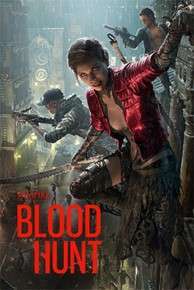 Blood Hunt is not one of those games and barely has any plot whatsoever (sort of-see below). It is a battle royale game where you pick a vampire archetype, go out into the streets, and fight other players in an increasingly smaller ring until only one of them remains. Sometimes, you can fight computer-controlled enemies as well.
Blood Hunt is not one of those games and barely has any plot whatsoever (sort of-see below). It is a battle royale game where you pick a vampire archetype, go out into the streets, and fight other players in an increasingly smaller ring until only one of them remains. Sometimes, you can fight computer-controlled enemies as well.
There actually is a plot to the game that was being steadily updated by the developers until recently, but it is something that is incredibly hard to engage with. Prince Markus of Prague’s undead are hosting a peace conference between Anarchs and Camarilla agents before the Second Inquisition attacked as well as the attempts by the Brujah Sheriff to take over the city. However, finding out these details is very hard since the characters aren’t voiced and there’s no Codex for describing who is what or what they’re up to.
The city of Prague is well-realized, and the Elysium has a lot of character to it despite its small size. It looks like a Triple A game, and you can practically smell the environment. There’s a lot of verticality to the setting as well as environmental storytelling. Prague is presently under a lockdown by the Second Inquisition (called “The Entity” for some reason) and there’s little bases spread throughout the map. I think they did a fantastic job on the graphics and give them a lot of credit for capturing the “look” of what I think a Vampire: The Masquerade game should appear like.
I also really enjoy the use of verticality in the game with the fact that all the vampires can climb the buildings around the location. If you’re losing a fight against a fellow vampire, then it’s entirely possible to just leap over the side and fall forty feet to get away. There’s ladders on the side of buildings that aren’t meant for the undead but help immersion. I also like the Blood Hunt rules where you suddenly become a huge target for other players if you feed on a mortal with witnesses or kill an ordinary human for no reason (or more likely mistake them for a fellow vampire). Solo players get two lives, which is a great innovative idea to encourage players.
At heart, the game is a battle royal, though. The rules are simple, thirty players or however many players and some bot enemies, jump into the fight only to hash it out. There’s a magical red circle that gradually tightens around the player characters before eventually leaving only one victor. You find weapons in the area, you feed on bystanders, and you try to survive until the end. You level up, you try to win cosmetics, and you switch around the various kinds of vampire you can be.
The game is fun to play but not as fun to play that I would continue to play it indefinitely. The developers have substituted bots for its dwindling player base, but this is really just a patch on the fact it’s not something that I would want to play for hours on end. There are also sidequests in the open world that just don’t work well with the battle royal format.
It’s unfortunately probably too late to save this game and I really hope they save the assets of the game for something else. They really could do a great Vampire: The Masquerade game set in the Prague open world they created. It probably is a backhanded compliment to the developers that it would be awesome to do a single player game made from their game’s corpse, but it just wasn’t what I was looking for.
The post REVIEW: Vampire: The Masquerade Blood Hunt appeared first on Grimdark Magazine.
April 5, 2024
REVIEW: Scream in Blue by Jeremy Szal
From the author of Stormblood, Blindspace, and the soon to be released Wolfskin, the novella Scream in Blue takes us away from the far-flung asteroid city of Compass and into more familiar territory: 25th century London. Full of action, bad decisions made for the right reasons, alien biotech, and sticking one’s finger up at something you can’t hope to defeat, Scream in Blue gives us more of what I really enjoyed about Stormblood.
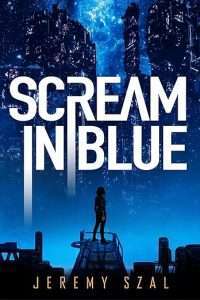 Sola And her crew of fellow roof-jumper Tann and their hacker Quinn are Crawlers, moving through the centuries-old spiderweb of the London Underground and across the rooftops to steal things under contract from Syndicate entities. They’ve never stolen stormtech—the alien drug that binds to a persons system and turns them into to an adrenaline addict until they die in a fight or burn out as a junkie and die–until now.
Sola And her crew of fellow roof-jumper Tann and their hacker Quinn are Crawlers, moving through the centuries-old spiderweb of the London Underground and across the rooftops to steal things under contract from Syndicate entities. They’ve never stolen stormtech—the alien drug that binds to a persons system and turns them into to an adrenaline addict until they die in a fight or burn out as a junkie and die–until now.
The far future version of London is beautiful and very cyberpunk gothic, with plenty of high-tech gadgets and weapons amongst the crumbling of society. The stormtech drug of course lends its awesomeness to the story, with cartel members flush with it on destructive rampages, and addicts (“skinnies”) on show in all their horror. As a current reader, I did kind of hope to see mention of the Reapers, but that is for another book (Stormblood. Read it. It’s awesome), but I think the story worked really well without them.
What I really enjoyed about this tie-in story is Szal’s pre-novel-debut short story chops being on show. The author has a very tall stack of short story publications in the global market, and his ability to avoid the novel author’s mistake of writing a tie in story nobody but the current fandom can appreciate is very appreciated from this reviewer. Here, we have a stand-alone story with enough link to the trilogy to garner interest from a new reader, and to enjoy when you’re an established reader.
Scream in Blue is a fun, short read, with plenty of action, intrigue, and camaraderie.
Read Scream in Blue by Jeremy SzalThe post REVIEW: Scream in Blue by Jeremy Szal appeared first on Grimdark Magazine.
April 4, 2024
REVIEW: Bridge of Kings by Logan D. Irons
Bridge of Kings by Logan D. Irons is the origin story of two characters in the Oaths of Blood trilogy. Full of battle, Vikings killing English (and vise versa), and plenty of Viking-style death and commentary, Bridge of Kings is a novella that doesn’t work tremendously well as a stand-alone work, but I’m sure would land with far greater meaning for fans of the trilogy.
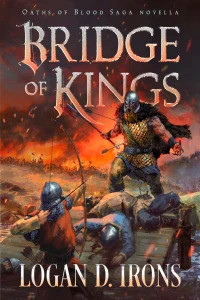 What I liked about this novella was that it plays on a trope that I love, and have loved since I was very young: self sacrifice to hold a choke point against all odds. The setup is done well, and the author does an excellent job of painting the playpen for our imaginations to go wild in as we watch the story unfold. I also really enjoyed the wolfskin fantasy element, with that POV chapter being a particularly fun part of the novella.
What I liked about this novella was that it plays on a trope that I love, and have loved since I was very young: self sacrifice to hold a choke point against all odds. The setup is done well, and the author does an excellent job of painting the playpen for our imaginations to go wild in as we watch the story unfold. I also really enjoyed the wolfskin fantasy element, with that POV chapter being a particularly fun part of the novella.
While the closer focus individual parts of heroism and fighting were fun to read and I had a great time throughout these sections, the battle overall, for me, lacked the simultaneous movement required of larger scale battles to make them feel real and engaging. Many things seemed to wait on each other to happen before moving in chronological order as opposed to showing the many moving parts of two armies in conflict at once—even restricted through the viewpoint of one character as you would find in The Heroes by Joe Abercrombie.
The ending is the part that really didn’t work for me. The change from foe to friends–what I assume is the shift from the characters in this short work to the characters they are in the longer form novels–was too abrupt for me. Without insight into one of the character’s background their decision made little sense; and without the author going into earlier depth to build on about the other character’s his age and the impact of that on how he sees the world and those he fights with, then we have little understanding of his worldview until it gets dropped on us at the end.
Overall, Bridge of Kings isn’t a bad read if you love a good Vikings versus English battle scene. I don’t think it’s a great read as a stand-alone novella, but I am sure Iron’s fans would get a massive kick out of seeing how two characters who I assume are companions in the authors trilogy met.
Read Bridge of Kings by Logan D. Irons
The post REVIEW: Bridge of Kings by Logan D. Irons appeared first on Grimdark Magazine.
April 3, 2024
REVIEW: The Fall of the Giants by Gregory Kontaxis
The Fall of the Giants by Gregory Kontaxis is the second volume of his epic fantasy series, The Dance of Light, following up on his debut novel, The Return of the Knights. Originally published in Greek, The Fall of the Giants has been translated into English by Sophia Travlos and edited by K.E. Andrews, providing a polished reading experience that, for me, is indistinguishable from native English.
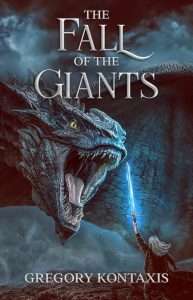 The scope of The Dance of Light series is enormous, filled to the brim with political intrigue and warring factions. Thankfully, Gregory Kontaxis includes a comprehensive list of characters and information on each kingdom at the beginning of the book. I found myself consulting the list frequently, especially during the early part of the book.
The scope of The Dance of Light series is enormous, filled to the brim with political intrigue and warring factions. Thankfully, Gregory Kontaxis includes a comprehensive list of characters and information on each kingdom at the beginning of the book. I found myself consulting the list frequently, especially during the early part of the book.
The Fall of the Giants brings greater nuance to all the principal characters of the series. I must confess that I was rather annoyed with the lead protagonist, Elliot, in The Return of the Knights, where he came across as brash and overconfident. I found Elliot to be much more realistic, and therefore more relatable, in this second book of the series.
As in The Return of the Knights, I enjoyed the over-the-top villainy of Walter Thorn, a local warlord trying to overthrow Queen Sophie of Knightdorn. Another favorite villain is John (the “Long Arm”), a former bounty hunter and member of Walter’s inner circle, whose backstory is given in the excellent prequel novella, The Knight of the Moon.
Nevertheless, my favorite character in The Fall of the Giants is Queen Sophie herself. She is, perhaps, the most complex character in the series, a lonely monarch who has lost most of her family and close allies. Sophie is weary from carrying the weight of a crown that she feels ambivalent about at best.
The main story of The Fall of the Giants concerns a competition between Elliot and Walter as they seek to form alliances with various legendary races. While Elliot strives to free the Elder Races, elwyn and elves, Walter pursues a fearsome set of allies in giants and their most loyal companions, the terrifying wyverns. With the power of giants and wyverns on his side, Walter could become unstoppable.
Kontaxis maintains a steady pace throughout this second volume of the series, never lagging as the story builds up to its striking climax. Despite the obvious comparisons to A Game of Thrones, Kontaxis has a tighter focus on the key storylines compared to George R.R. Martin. However, The Dance of Light series also dials back on elements of gray morality compared to Martin’s A Song of Ice and Fire. Personally, I would have preferred a bit more moral ambiguity in the lead characters in The Fall of the Giants.
Overall, The Fall of the Giants improves upon The Return of the Knights in every way, delivering an impressive epic fantasy that brings new layers of nuance to both the characters and story.
Read The Fall of the Giants by Gregory KontaxisThe post REVIEW: The Fall of the Giants by Gregory Kontaxis appeared first on Grimdark Magazine.
April 2, 2024
REVIEW: La Revolution
Set in 1789, La Revolution on Neflix asks the question of what would the French Revolution look like if King Louis tricked the heads of the noble families into a state of undeath to bind them to him in lordship over the people forever, right when the people hit their breaking point. Dark and gritty, bloody and full of horrors and allegory, La Revolution is a fun bit of television until we get deep into the series and it starts to lose its way.
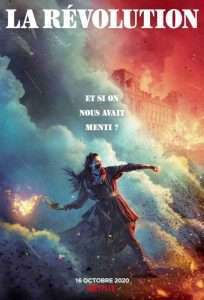 Before I get further into this, I am just going to outright state that I am not a historian. I have not studied the French Revolution, nor the period of time in that country, and so while I am sure there are a really tall stack of misrepresentations, artistic licence, and faux pas in the show, it is essentially a period piece meshed with the undead, so let’s move on from it, yeah?
Before I get further into this, I am just going to outright state that I am not a historian. I have not studied the French Revolution, nor the period of time in that country, and so while I am sure there are a really tall stack of misrepresentations, artistic licence, and faux pas in the show, it is essentially a period piece meshed with the undead, so let’s move on from it, yeah?
In La Revolution a physician for the poor, an aristocrat who sees what’s coming, a brother hiding his sibling’s affliction, and a man returned from the dead tell our story. The nobles have everything and live lives of unrivalled pop and luxury, while the people scrape and struggle to survive. A revolution is boiling, waiting to explode, and our main characters give us different perspectives into the events of the nation, from investigating the local gory deaths of young women, to the machinations of the nobles as they decide whether to back the king or to support the people, to the grand plan of King Louis. Those are some damned fine bones upon which to build an engaging season of television.
The acting is excellent, the feel of the world is beautiful and the FX are downright magnificent. On a fantasy horror history feeling level, this series has everything I want to hook me in and keep me watching. The first half of the season really nailed it for me, and I pretty much could not stop watching it. However, the back end of the season quite lost my interest.
The introduction of the new Count character mid-season moved the story away from grey morality—with even the nobles’ fear of loss of power and intense (read: murderous) want to protect their own family from King Louis’ duplicity–and into the ridiculous pure evil character-style story. While this was likely an allegory for the pure evil of dictatorships / nobility and their incessant need to feed off their peasants (quite literally!), I think they had achieved that with the Count’s brother, the infighting of the nobles, the blue blood of the undead (I see what they did there), and the next level, to me, seemed unnecessary.
It really got a bit silly at the end, to be honest. The gory escalation and the drive towards the revolution was great, but the betrayals and twists got a bit ridiculous. In the last episode, in particular, the writers were trying to drop story bombs, but I ended up just getting hammered with confusion.
Having said that, something that needs to be mentioned is the dubbing work done by Netflix to bring this French show to an English-speaking audience. I was fully expecting the usual average, scenery chewing voice acting that consistently breaks your concentration in these Netflix dubbed shows. However the dubbing acting is so well done in La Revolution, I often forgot the actors weren’t actually speaking English.
La Revolution is a dark, gritty fantasy horror period piece that is quite fun to watch. With a strong start that deteriorates over the course of the season where I struggled to remain interested, I am glad I watched it but will unlikely delve into the second season.
Watch La Revolution over on Netflix.
The post REVIEW: La Revolution appeared first on Grimdark Magazine.
April 1, 2024
REVIEW: Werewolf: The Apocalypse
Werewolf: The Apocalypse has always been about third or fourth in my favorite of the World of Darkness games. Which is not so much an insult or a question of its quality as the fact that I was an obsessive Vampire: The Masquerade and Mage: The Ascension player. Furthermore, I was brought into my fandom by Changeling: The Dreaming which was always the odd man out but a lot better game than most people ever did.
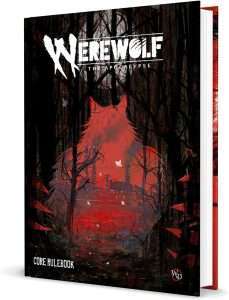 The premise is that you are, unsurprisingly, a werewolf and a warrior for Gaia, the spirit of the Earth. Captain Planet jokes were being made even in the Nineties. The Earth is dying, and you have to stab or claw some folk to save her. Unfortunately, all Garou are good at is clawing or stabbing people, so they’ve unwittingly alienated or killed off all their fellow shifters as well as each other. One of the cooler elements of the premise is the Garou are a hammer that has been treating every problem as a nail for 20,000 years.
The premise is that you are, unsurprisingly, a werewolf and a warrior for Gaia, the spirit of the Earth. Captain Planet jokes were being made even in the Nineties. The Earth is dying, and you have to stab or claw some folk to save her. Unfortunately, all Garou are good at is clawing or stabbing people, so they’ve unwittingly alienated or killed off all their fellow shifters as well as each other. One of the cooler elements of the premise is the Garou are a hammer that has been treating every problem as a nail for 20,000 years.
Werewolf is a fantastic game and I’d argue that is probably the best written game after Vampire: The Masquerade, even more so than Mage. However, like Mage, it suffered something of a problem with its own fandom. Without naming names, about 2000 or so, a developer told me the game had a white supremacy problem. A bunch of future Alt Right gamers were attracted to the game because of its themes despite the games’ dogged (no pun intended) pro-indigenous rights and environmental themes. Clumsy writing, cultural appropriation, misuse of terms, and things like “Pure Breed” as a background meant the developers had way too many people taking the exact opposite of the message intended by the writers.
If it feels like I’m digressing too much versus talking about the book, resolving a lot of those issues were major factors in the writing of Werewolf: The Apocalypse Revised and they’ve done even more overhauls to the Garou for 2023. Some of these changes have been ones that fans have been requesting for years, some of these make the game more like Werewolf: The Forsaken, and a few of these changes are just bad ideas.
As usual, there’s a bunch of behind-the-scenes drama that I won’t get into, but I think is pretty much inevitable with competing artistic visions. Werewolf, like a proper World of Darkness game, says things and because of that someone is going to be offended. Sometimes rightly, in my opinion, so caveat emptor as the 5th Edition of the game is overall a mixed bag but not terrible from a lore or mechanics POV.
Lore-wise the game takes the premise the Apocalypse is either happening or has happened with the Garou having lost the war. It takes the themes of the Garou screwing up saving Gaia to their natural conclusion and now most werewolves feel like the cause is hopeless. The Get of Fenris have become the Cult of Fenris and become fanatical zealots divorced from the rest of the Garou Nation. The fandom telephone game says the Cult have been taken over by Nazis and white supremacists but while you can read that into the text, they are only written as suffering the worst stereotypical behavior of old Garou being violent psychopaths who kill anything that they think is even vaguely Wyrm-y.
Indeed, the mechanics have weaponized being an old school “kill ‘em all and let Gaia sort ‘em out” attitude of previous Werewolf editions and made it a condition like Harano (supernatural depression that I’ve always felt uncomfortable with as a neuroatypical person) called Hauglosk. The Get falling to evil is a very questionable thing as they were one of the more popular tribes and it seems strange to have them go full fanatic while the Red Talons remain part of the Garou Nation. Out of game, it seems this condition basically exists to clarify the Garou’s history of violence to solve all their problems was idiotic. Which I thought was clear from 1st Edition.
Other changes include getting rid of Crinosborn (my term for Garou-Garou children versus the one they used to use) and getting rid of the genetic component of the race. Like the Force, certain families have stronger chances of being Garou but it’s not a 100% genetically inherited trait. Which admittedly does tone down the issues of Kinfolk from previous editions. Oddly, I’d say that is the much bigger retcon than anything related to the Get. Mind you, the game wants to have its cake and eat it too as some Garou clearly believe it’s still genetic but it’s now clear that they’re flat out wrong. Still, I wanted to know about how this affected Garou-Garou marriages, their relationships with mortal families, and more. Maybe next book.
The tribes have been divorced of their historical cultural origins, which is a more questionable action as well despite understanding the logic thereof. The Fianna have become the Hart Wardens while the indigenous tribes have become Galestalkers and Ghost Council. I won’t even use their original names because they turned out to have been highly insulting so, good call. Ditto my favorite tribe of Samuel Haight’s tribe (which, again, was a no-no in its name). They’re now called the Stolen Moons. Overall, I understand the decision-making process here and mostly think it was a good idea to re-examine the handling of indigenous culture among Garou.
Without going into another digression, basically indigenous rights were always a major background theme of Werewolf and clumsily handled. If you wonder how clumsily handled, a pair of examples is the fact there used to be tribes called the Croatoan (descended from South Carolina Native Americans) and Bunyip (Aboriginal Werewolves) before they went extinct. The problem being the Croatoan are a real-life ethnic group that some people still claim ancestry of today and, well, I’ve talked to Australian gamers of said descent who would like to point out their ethnic group is still around so why can’t they be werewolves?
Thus, these groups have been reduced to septs or “micro-tribes” with a page lamenting European colonization’s effects before moving on. Is it a good thing or a bad thing to reduce the role of native peoples in Werewolf when so much of the original game was about Western civilization encroaching on traditional peoples? I dunno. The original game took a heavy pro-First Peoples stance in a clumsy and ham-fisted way primarily written by well-meaning white dudes. I support the message even though it was badly framed. Strictly speaking, though, now you can just use the existing Garou tribes anywhere on Earth and give them local variants.
After having spent a thousand words discussing the politics of a Nineties Gothic Punk game moved into the 2020s, how is the actual game? Well, it’s fine. It’s a bit less focused. Adding an existentialist element to the setting about the fact the war against the Wyrm is probably pointless opens more storytelling opportunities. Climate change activists may think now is the most important time to be fighting Pentex but the urgency is gone if you want to run a sept just about looking after your old neighborhood. The Garou aren’t going to save the world on their own so they might as well save their whatever we’re calling kinfolk now.
Mechanically, the game is fine and will function for what the player wants it to as well as the Storytellers. I don’t have any objection to the changes that feel comparatively tame versus Vampire: The Masquerade 5th Edition’s. Gifts are tied to Willpower and Renown instead of Gnosis (which no longer exists). The addition of Loresheets is also welcome as I’ve always found those to be exceptionally useful. Speaking of similarities, the book also indicates the Second Inquisition knows about Garou and is hunting them as well. Just not in the numbers or with the same success as vampires (which makes sense given the Delerium). The biggest change really is Hauglosk and that essentially functions as Humanity for werewolves but shouldn’t be a problem for PCs as long as they don’t violate Chronicle tenets. It is also contrasted with the addition of Harano as a form of Garou depression. Basically, werewolves struggle between existential despair and furious self-righteousness. Touchstones also indicate at least some werewolves will keep in touch with their human relations as before.
In terms of mechanics, the game remains a game about being a murder machine that can transform between five different forms (man, wolf, manwolf, mostly man, mostly wolf). The vast difference in lore means that some of these changes make a few things feel redundant. Auspices and Breed are far less important since Garou have had most of the differences leveled out between them. Being a Lupus-born werewolf (i.e. born of wolves) used to be a fun chance to be an alien mindset but has been greatly de-emphasized because I suspect people kept asking about whether you were expected to boink other wolves. No, I’m not kidding. Forums are weird.
The handling of Hauglosk and Harano alongside Touchstones is also not very well designed. In theory, I like the mechanical focus on personal horror. I feel like the struggles with being a werewolf and how it can destroy your personal life and drive you to existential depression or murderous evils was de-emphasized after First and Second Edition. However, the mechanics for both in this game are just bad. There doesn’t seem to be a way listed to remove points in either of these stats and that means Garou are doomed for very short lives before becoming NPCs. Which is not how the game portrays running Chronicles and thus is probably just bad game design.
The game also meanders about what exactly Garou are supposed to be doing with their time as furry killing machines. Previous games had the easiest to explain and most-well defined purpose of all the games: “You are a werewolf. You are to save the Mother Goddess from the Wyrm. Go kill evil spirits and the corporate bigwigs destroying the world.” The book focuses overmuch on how the Garou have screwed up this task and how their “kill everything bad” attitude has not improved things. It gives mixed messages about what you’re expected to do as a werewolf. The Renown System thus feels tacked up even though its central to acquiring Gifts.
Another major change to the game is the fact the role of the Umbra has been massively de-emphasized. The Garou no longer can step sideways into the spirit world as long as there’s a nearby reflective surface but have to use a rite called “The Rite of the Shadow Passage.” Furthermore, Garou will take a point of Aggravated Damage for every scene they are in the Umbra unless they spend a point of willpower. Previous Chronicles could spend entire adventures in the Umbra, so this feels like crippling it in a way like the Avatar Storm of Mage: The Ascension Revised.
I feel the systems are a lot faster and some of the overpowered nature of the Garou have been shed in the changes. Certainly, Werewolf: The Apocalypse Fifth Edition feels like it could be more easily ported over to other lines (in this case Vampire: The Masquerade and Hunter: The Reckoning). I’m not sure that is the best use of game designers’ time, though, as they’re still extremely different in scope as well as theme. Some of the obvious flaws of interaction are also not dealt with like the fact hunters are aid to react differently to the Delerium then it says some act exactly the same while giving no examples why they would.
So, what’s my take? Eh, my take on Fifth Edition is that it is a deeply uneven revision. It’s got some good ideas and some bad ideas. I feel like the depth of the changes are somewhat exaggerated, though, and people have read into things that aren’t there. I disagree with some of the choices while am generally able to follow the logic of most decisions.
Read Werewolf: The ApocalypseThe post REVIEW: Werewolf: The Apocalypse appeared first on Grimdark Magazine.
March 31, 2024
REVIEW: The Wings Upon Her Back by Samantha Mills
In The Wings Upon Her Back by Nebula, Sturgeon, and Locus Award-winning Samantha Mills, Winged Zemolai, a winged warrior in servitude to a warrior god makes a mistake. She is tired, her bones ache as much as her soul; her life of soldiering sits upon her like a heavy blanket. And that one poor decision tears her away from her life and from the leader she idolises.
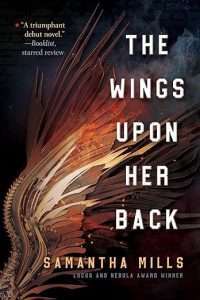 The Wings Upon her Back is told in two timelines. In the first, Zenya (not yet Winged Zemolai) is born into the scholar god sect, one of five sects the people of her hermit-nation have divided themselves into to follow the increasingly absent teachings of the five gods who watch over them. In the second timeline we see Zemolai as a war-weary warrior who left her family and the scolar sect to obtain her wings and fight in the sky. Her body is falling apart, she is sick of the fighting but knows nothing else and sees no other value in herself, and who, in a moment of weakness (from a zealotry perspective) makes a decision that irreparably changes her life.
The Wings Upon her Back is told in two timelines. In the first, Zenya (not yet Winged Zemolai) is born into the scholar god sect, one of five sects the people of her hermit-nation have divided themselves into to follow the increasingly absent teachings of the five gods who watch over them. In the second timeline we see Zemolai as a war-weary warrior who left her family and the scolar sect to obtain her wings and fight in the sky. Her body is falling apart, she is sick of the fighting but knows nothing else and sees no other value in herself, and who, in a moment of weakness (from a zealotry perspective) makes a decision that irreparably changes her life.
Across these two timelines, her progression through training as Zenya (to become Winged Zemolai) with her mentor and leader, when juxtaposed against the person she becomes in the events after the mistake which upends her life, is an excellently grown story. It slowly reveals how Zenya became this world-weary warrior while also exploring the inner turmoil of the people of her city driven by infighting between the leaders of the sects.
While the commentary on isolationist governments (probably some of our democratic ones, too) and religious zealotry is a fun read, The Wings Upon Her Back is really a story about the abuse between two people, and what can happen when you idolise somebody and making that person happy becomes the core of your your own happiness. I think that most of us have been there at some point in our lives, in some form or other—in our relationships with a friend, a boss, a partner—and when memories of those times in my life come to mind while reading, those scenes in the book really hit home.
I also really liked the way the author gave an insight towards the end as to why Zemolai’s leader is who they are—what drove them to this point. It showcases how this behaviour can be generational trauma that just keeps being passed down from leader to leader, poor decisions compounding as each leader is too afraid to try another way. And while Zemolai and the bolt baby’s decisions–as they grew their understanding of each other–didn’t always land with me in the moment, I think the author took me on a really enjoyable ride through her world.
Zemolai is a character style that I love more the older I get—that kind of ageing warrior with a cupboard of bad decisions locked away, the sounds of the door breaking open almost masked by the sounds of crunching hip and knee joints—and that certainly helped in my enjoyment of the book. I think if you’re a grimdark fan and that kind of character appeals to you as well, then this novel is going to tick quite a few boxes for you, too.
Fast, fun, and set in a brilliant science fantasy world, The Wings Upon Her Back by Samantha Mills is one of those really good books that reaches into your own life experience to draw upon memories that drive your emotional reaction to the story.
Read The Wings Upon Her Back by Samantha MillsThe post REVIEW: The Wings Upon Her Back by Samantha Mills appeared first on Grimdark Magazine.
March 30, 2024
REVIEW: Empire of the Damned by Jay Kristoff
Empire of the Damned continues the bloody and unforgiving tale of the silversaint Gabriel de Leon. Gabriel remains the prisoner of the vampire Margot, the Empress of Wolves and Men, and she wishes for the infamous legend’s story to be told to future vampire generations. The historian Jean-François is again the chronicler of these events, even though he and Gabriel did not conclude Empire of the Vampire on the most civil terms. Reluctantly, with many inventive swears and sarcastic wit, Gabriel relays the next stages of his heroic and tragic life. The action picks up with Gabriel, Dior Lachance, and a ‘deathless bloodmage’ contemplating what to do next regarding the vampire assaults and domination of Elidaen, and how they can go about ending the eternal night of daysdeath.
 Gabriel dislikes vampires. Throughout this part of his recounting, he has a vendetta to settle with the most powerful vampire in the empire, Fabien Voss. Although Blood Voss are a constant presence and threat to the Silversaint and those he holds dear, Blood Dyvok are the main adversaries in Empire of the Damned. This house contains brutal, seductive, intelligent vampires, intriguing politics and histories, and are mysteriously much more powerful than they have any right to be. They have recently taken hold of the formidable Dun Maergenn and about forty percent of the novel happens within this city’s walls.
Gabriel dislikes vampires. Throughout this part of his recounting, he has a vendetta to settle with the most powerful vampire in the empire, Fabien Voss. Although Blood Voss are a constant presence and threat to the Silversaint and those he holds dear, Blood Dyvok are the main adversaries in Empire of the Damned. This house contains brutal, seductive, intelligent vampires, intriguing politics and histories, and are mysteriously much more powerful than they have any right to be. They have recently taken hold of the formidable Dun Maergenn and about forty percent of the novel happens within this city’s walls.
Empire of the Damned features an almost perfect mix of familiar characters and new exciting players in Kristoff’s well-realised fantasy world. A former Silversaint apprentice of Gabriel’s and members of Dun Maergenn’s court, both vampire and civilian, make great additions. As mentioned, we are presented insight into yet unfamiliar vampire houses, plus revelations regarding skinchangers, and the holy vampiric faction of the Esani. It makes for gripping and detailed worldbuilding as readers learn further details while Gabriel reflects on his escapades.
While recounting his story, one day to be read to the vampire children of this world, the banter and exchanges between Gabriel and the historian are once again top-notch. The back and forth is a battle-of-wits, a multilayered and energetic verbal joust. As per the previous book, Gabriel drinks a fair amount of wine as he dictates but, in his current predicament, the joys in his life are currently limited.
 Alongside the present day happenings of Gabriel and Jean-François, Empire of the Vampire presented two distinct storylines at varying stages of the silversaint’s illustrious vampire-destroying career. Empire of the Damned focuses on one flashback period, making up most of the narrative and this was welcome to me, getting my teeth into this drama wholeheartedly. I understand the need for many authors to have the formative years sections, especially in the first novels of a series and this was worked proficiently in the previous entry. Kristoff does alter his presentation with how the narrative is delivered at certain points. This was initially unexpected and extremely fulfilling so I will not go into the details. I enjoyed the change in dynamic so much, that I would not want to take that moment of realisation away from other readers.
Alongside the present day happenings of Gabriel and Jean-François, Empire of the Vampire presented two distinct storylines at varying stages of the silversaint’s illustrious vampire-destroying career. Empire of the Damned focuses on one flashback period, making up most of the narrative and this was welcome to me, getting my teeth into this drama wholeheartedly. I understand the need for many authors to have the formative years sections, especially in the first novels of a series and this was worked proficiently in the previous entry. Kristoff does alter his presentation with how the narrative is delivered at certain points. This was initially unexpected and extremely fulfilling so I will not go into the details. I enjoyed the change in dynamic so much, that I would not want to take that moment of realisation away from other readers.
Empire of the Damned delivers many moments of high-intensity, including memorable showdowns, exchanges, and unpredictability, with very little going the way expected or in Gabriel’s favour. Certain scenes may arguably be over the top yet Empire of the Damned is an undeniably addictive and fun read. Yes, with some characters’ incredible powers of recovery, sometimes it seems as if fights do not have concrete consequences (Gabriel has many broken ribs!). Moreover, when reading it is not always obvious when someone’s death means a character is actually dead. These minor points do not take away from the stunning spectacle that is Empire of the Damned. It is a dark fantasy read/experience of the highest quality, with an amazing and tragic finale that is worthy of these well-conceived 700 pages. Fellow Grimdark Magazine reviewer Fiona advised me that she was a ‘whirlpool of feelings’ when she finished this novel, and I concur, believing that is an excellent way to express post-Empire of the Damned emotions. The next entry in this series cannot come soon enough.
I received advanced review copies in exchange for an honest review. Thank you to Harper Voyager and St Martin’s Press.
Read Empire of the Damned by Jay KristoffThe post REVIEW: Empire of the Damned by Jay Kristoff appeared first on Grimdark Magazine.



